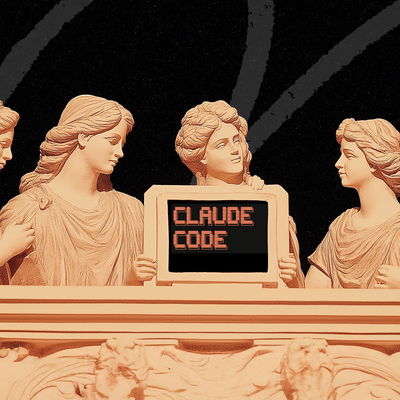.png)
Was this newsletter forwarded to you? Sign up to get it in your inbox.
There's a tool that developers are using to 10x their productivity that most non-technical people don't even know exists—much less that they could be using it too.
It's called Claude Code, and at first glance it looks like something you shouldn't be allowed to touch unless you know how to write code. The black box terminal (the window where developers type their code). The cryptic commands. The unintelligible permissions requests.
After months of working with Claude Code at Every, we’ve discovered that it isn't just for developers. It's the more powerful version of what you're already using in the Claude app. And if you're hitting limitations there, you can do more with Claude Code.
That was the theme of our latest Claude Code Camp, the live event series where Every's team members share how they use AI tools in production. Nearly 400 subscribers joined to learn how to use Claude Code for non-developer tasks like:
- Building expense trackers that automatically categorize business trip spending across multiple credit cards
- Analyzing massive content datasets to identify which types of stories and introductions drive the highest engagement
- Researching technical codebases to answer customer support questions without having to ask engineers
- Generating marketing content by reviewing recent code changes and drafting copy for a feature release newsletter
Here are the highlights, plus practical demos you can try yourself.
Key takeaways
- Claude Code removes artificial limits. File size restrictions, context window caps, and chat length constraints disappear when AI runs on your computer instead of in the cloud.
- It's AI with training wheels off. Features slowly rolling out in the Claude app already work more powerfully in Claude Code because it's designed for developers who need maximum capability.
- Start simple, then graduate. Don't jump straight to Claude Code for everything. Try the web app first. When you hit limitations, that's your signal to make the leap.
- Installation is easier than you think. Download Claude Code, then open your terminal (it's already on your computer), type “claude,” and you’re ready to go.
What Claude Code is (and why it matters)
Claude Code is Claude running in your terminal—that mysterious box programmers type into. Every computer has one. On Mac, you open Spotlight and type "terminal." On Windows, it's just as easy (ask ChatGPT or Claude how).
The key difference from the chat window you may be used to is that Claude Code runs on your computer, not in Anthropic's servers. This makes it more powerful in three ways:
- Access to all your files, any size. The app requires you to upload files manually, with size limits. Claude Code has access to everything on your computer and can handle massive files without breaking.
- Long-horizon tasks. The cloud app can get confused when chats get too long or tasks too complex. Claude Code can work for hours on elaborate projects because it's running locally and has unlimited memory of what it's doing.
- No artificial limits. Because it's not constrained by cloud infrastructure, Claude Code can browse the internet longer, process more data, and chain together more complex workflows.
Every CEO Dan Shipper used this analogy: "The cloud app is like a hotel room—clean, set up for you, but you start fresh each time. Claude Code is like having your own apartment with AI in it. You can customize it, build on it, and create something together over time."
When you should (and shouldn't) use Claude Code
Dan laid out the decision tree as to when you should use either app.
Use Claude Code when:
- The cloud app file limits are blocking you.
- Your task needs to run for longer than the cloud app allows.
- You're working with multiple large spreadsheets or documents.
- You want to experiment and understand what's at the edge of AI capability.
- You need to automate something you do repeatedly.
Stick with the cloud app when:
- Your task is straightforward and fits in one chat.
- You're just starting to explore AI.
- File sizes and context limits aren't an issue yet.
- You want the easiest, most polished experience.
Real workflows from the Every team
The best way to understand Claude Code's power is to see it in action. Here's how different members of the Every team use it to handle tasks that would bog down the regular Claude app.
Expense tracking (Dan)
Dan uses Claude Code to build simple expense reports after business trips. He downloads his credit card transactions, drops them in a folder, opens his terminal, types “claude,” and gives it the command: "Make an expense report on a single web page. Identify all expenses from last week and create a simple web page broken down by category." Ten to 20 minutes later, he has a working expense tracker.
Over time, he can keep adding expenses to that folder and Claude Code will keep updating the tracker. Because everything lives on his computer, the system gets smarter with each trip.
The workflow: Download transactions → Drop in folder → "Make an expense report" → Wait 10-20 minutes → Get categorized web page.
The Only Subscription
You Need to
Stay at the
Edge of AI
The essential toolkit for those shaping the future
"This might be the best value you
can get from an AI subscription."
- Jay S.
Join 100,000+ leaders, builders, and innovators

Email address
Already have an account? Sign in
What is included in a subscription?
Daily insights from AI pioneers + early access to powerful AI tools










Comments
Don't have an account? Sign up!
Hooking Claude Code up to Playwright MCP is a game changer. It's like giving eyes and hands to an LLM in the best possible way. I no-code automated my whole online grocery shopping experience, had it walk me through a complex CRM software we use, and have it running deep research in a more fluid, transparent way. Claude Code has become my go-to AI agent.